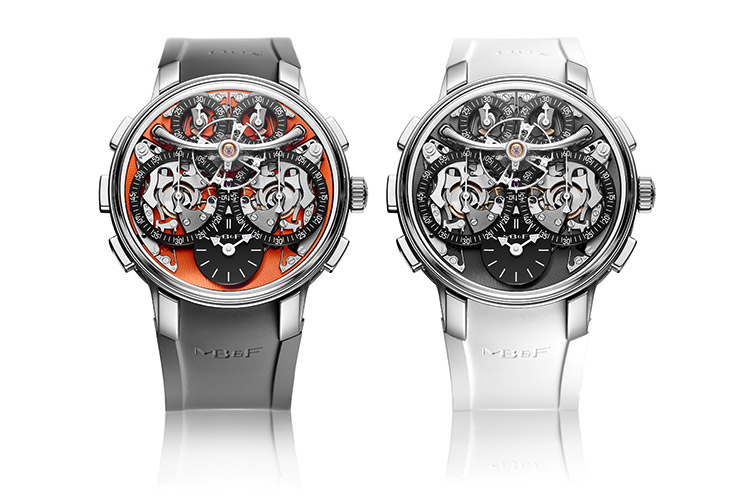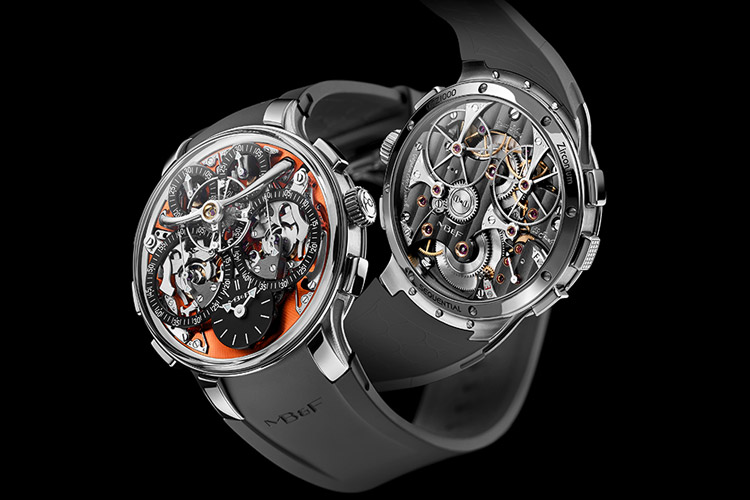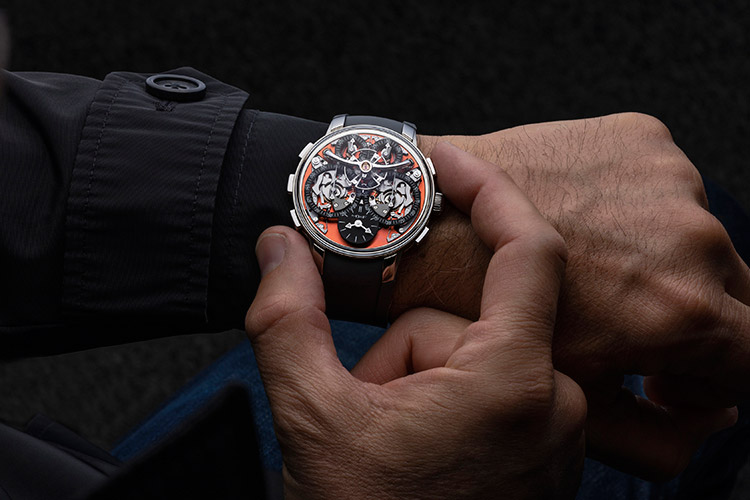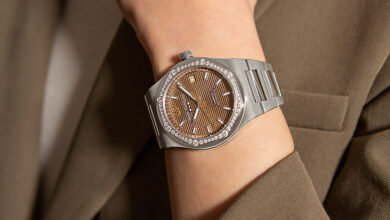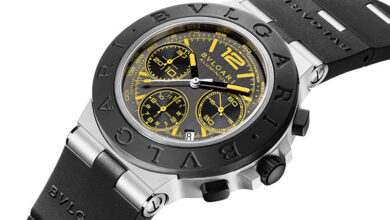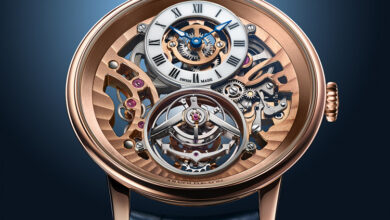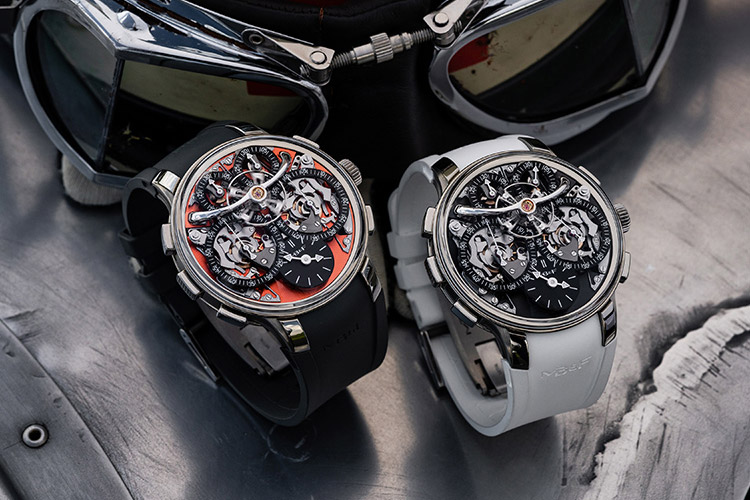
The world’s first-ever horological concept laboratory MB&F has introduced Legacy Machine Sequential EVO, featuring the debut appearance of MB&F’s 20th movement, in the first chronograph wristwatch of MB&F. Indeed, it is also the first chronograph wristwatch of its kind. We chatted with Maximilian Büsser, the MB of MB&F, about his latest creation to uncover the genius behind the LM Sequential EVO…
Maximilian Büsser:
A Desire…
“The LM Sequential EVO LM Sequential EVO is a Dubai-created product; I was so fed up about not being able to wear one of my watches when I am in the water. For many years, I have been wearing the Perpetual on a strap, and I thought that I wanted to create a piece that I could actually wear in the water. I chose the Perpetual as the first model of the Evo line as it is the watch that I want to wear.”
Genesis…
“At Dubai Watch Week 2016, I was showing Stephen McDonnell a watch that I had just bought at Christie’s – a split-second chronograph pocket watch from Tiffany & Co. – and of which I was very proud. He was totally unimpressed and told me that chronographs don’t make any sense in the way they work – the same thing that he had told me about perpetual calendars five years before … Early 2018, he came to see us in Geneva with the design of what is now more or less the Sequential.”
Functions…
“The first function is that we have totally independent chronographs, the second is the split-second so that you can start both chronographs at the same time, and then we have the sequential chronograph with which you can time different laps, and then we have the Chess Aggregator that can record cumulative spends. In the sequential chronograph, at the end of every lap, it goes back to zero while in the Chess Aggregator, it does not go back to zero but keeps aggregating the different laps.”
Performance…
“Officially, the Sequential EVO has a power reserve of 72 hours with the chronograph on; actually, the power reserve is close to 95 hours without the chrono, and 84 hours with the chrono. We were able to do this because the clutch is always on, it is always engaged. When the chrono is working, there is more friction as the wheels turn.”
LM Sequential EVO
LM Sequential EVO is MB&F’s 20th calibre in just 17 years – and its first-ever chronograph – and was conceived with Stephen McDonnell, who previously reinvented for MB&F the perpetual calendar complication with the award-winning LM Perpetual.
Its movement incorporates two column-wheel chronographs and a ground-breaking “Twinverter” binary switch, allowing multiple timing modes including split-second and lap timer modes – a combination never seen before in any chronograph. The EVO case in zirconium features 80 metres of water resistance, screw-down crown, integrated rubber strap and the ‘FlexRing’ damping system.
Conceived by one of the very earliest MB&F collaborators and Friends, Stephen McDonnell, LM Sequential EVO explodes the current limits of what we thought chronographs could do. Just like the 2015 Legacy Machine Perpetual, the last major Stephen McDonnell movement for MB&F, LM Sequential EVO involved a back-to-the-drawing board approach towards our most basic assumptions on chronograph construction.
The dial plate of LM Sequential EVO, available in atomic orange or coal black, features two chronograph displays. One has its seconds display at 9 o’clock and minutes display at 11 o’clock. The other has its seconds display at 3 o’clock and minutes display at 1 o’clock. Each of these chronograph displays can be started, stopped, and reset completely independently of each other, using the start/stop and reset pushers on their respective sides of the case.
These make up the four chronograph pushers you would usually associate with having two chronograph mechanisms in one watch. However, there is a fifth pusher, located at the 9 o’clock position: the “Twinverter”. This pusher is the secret that elevates the functionality of the LM Sequential EVO beyond any existing chronograph wristwatch. It controls both chronograph systems, operating as a binary switch that inverts the current start/stop status of each chronograph.
This means that if both chronograph displays happen to be stopped (at zero position or otherwise), pressing the Twinverter will cause both of them to start simultaneously. If they are both running, the Twinverter makes them stop. If one is running and the other is stopped, the Twinverter stops the one that is running and starts the one that is stopped.
LM Sequential EVO can therefore be used just as you would any other chronograph, but thanks to its twin chronograph mechanisms, it can also perform the same functions as a split-seconds chronograph. In fact, thanks to the novel mechanical improvements to chronograph construction as conceived and implemented by Stephen McDonnell, it even outperforms conventional chronographs and split-seconds chronographs in terms of energy efficiency and precision.
But there’s much more: the switch function that comes with the Twinverter allows LM Sequential EVO to do things that no chronograph wristwatch, no matter how complicated, has been able to accomplish so far. Here are a few things that the LM Sequential EVO can do, that existing chronographs cannot:
“Independent mode”: Measure the duration of multiple events with separate starting points and end points, even when the events overlap in timing;
“Simultaneous mode”: Measure the individual durations of two events that start simultaneously, but have different end points;
“Cumulative mode”: Measure the individual cumulative durations of two discontinuous events;
“Sequential mode (or lap mode)”: Measure the individual sub-durations of a single continuous multiphase event, with provision for sub-durations that last over a minute. Simultaneous mode is used for example in a race involving two competitors, starting simultaneously.
The Twinverter allows to start both chronographs at exactly the same time, but the different end points can be easily recorded by pressing each chronograph’s individual start/stop pusher. To note, the durations of the events can exceed 60 seconds, which is the limit for the vast majority of split-second chronographs on the market.
Cumulative mode occurs frequently in the work environment, where you might want to know how much time you spend on two separate projects as you switch between them throughout the day. By starting one chronograph when you begin working on one task, and then using the Twinverter when you shift focus to the second task (switching again when you go back to the first), you can easily track the amount of time you cumulatively spend on each task. Another example of this usage is the timing of a chess match.
Sequential mode (or lap mode) has its greatest relevance in competitive sports, where it can be used to measure individual lap times. Starting one chronograph at the beginning of an event and using the Twinverter upon the completion of a lap instantly launches the second chronograph in order to time the next lap, while the first chronograph is stopped, allowing ample time for the timing result to be noted down. The stopped chronograph can then be reset to zero, ready to be relaunched with the Twinverter for the following lap.
